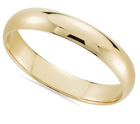 A wedding in Algeria is one of the most spectacular events in the world. Nevertheless, for centuries, the traditional wedding ceremony was concealed from the eyes of foreigners and was sort of a sacred occasion. But today, we already know how the celebration is held, what wedding traditions does Algeria have, and what do locals wear, eat, and do during the Algerian folk wedding. This is a story about two different weddings, and they differ in region, social class, clothing, some of the rituals, etc. Though, in general, the ceremony is similar and shows the beauty of Algerian wedding tradition.
A wedding in Algeria is one of the most spectacular events in the world. Nevertheless, for centuries, the traditional wedding ceremony was concealed from the eyes of foreigners and was sort of a sacred occasion. But today, we already know how the celebration is held, what wedding traditions does Algeria have, and what do locals wear, eat, and do during the Algerian folk wedding. This is a story about two different weddings, and they differ in region, social class, clothing, some of the rituals, etc. Though, in general, the ceremony is similar and shows the beauty of Algerian wedding tradition.
Algeria is the largest Arab country in the world and the biggest on the African continent. But some of its traditions are still concealed from the eyes of outsiders. This story goes inside a part of Algerian family life that has survived the centuries. Rich in tradition, spectacle, and celebration. Welcome to the traditional Algerian wedding.
We're going to talk about the wedding preparations and the ceremonies. And food will play a very big part at all of them.
Wedding preps
Tlemcen
The preparation started months previously, with the bride and her mother looking back at her wedding photos years before.
– It’s been a long time since we’ve looked at your wedding album.
– Do you want to know about preparations for wedding ceremonies?
– Yes.
– I was your age when my family was asked for my hand in marriage. Wedding ceremonies are still prepared in the same way today. I was wearing the kaftan. The chedda is the local bridal costume worn at our ceremonies.
Many women might resent parental interference these days, including Algerians, but Tlemcen is a conservative city, and the bride’s mother will play a big part in the preparations for the wedding – with her daughter's blessing.
Engagement
Today, the future bride is getting ready for the family of her intended to come and ask for her hand in marriage, so she has to look her best.
“In Algeria, the basic marriage rules are similar to other parts of the Arab world. Traditional weddings start with a meeting of the couple’s mothers. The boy’s family visits the girl’s family to ask for her hand in marriage. If they both accept, the couple is considered ingaged”, says Hadjira Haichour, heritage researcher.
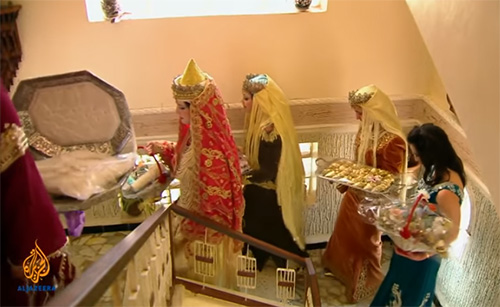
The female members of groom's family arrive at bride's house, dressed in costumes decorated with silk. And with gifts of Algerian traditional almond and honey cakes. The groom's mother, sisters, and other female relatives are visiting the bride's family to meet them formally, but also to check out the bride close-up.
Tlemcen
– I always tell my daughter that men prefer women who know their rights and duties.
– We really appreciate the way you’ve educated your daughter.
– A real woman is one who respects her family and her husband’s.
– That’s why we’ve chosen your family. Mrs. Djamila, we’re keen to see the bride.
When the bride enters, everyone greets her with spicial high-pitched sounds.
The bride's future mother-in-law formalizes the engagement by offering her a ring.
She also presents the bride with a series of gifts – ancient jewelry, embroidery, and traditional costumes that represent the influence of the Spanish region of Andalusia on the culture of the Algerian city of Tlemcen.
The bride's family responds by serving their guests a host of delicacies made with almonds and other nuts, flavored with rose water and citrus. Milk, a symbol of purity and good luck, is also on the menu.
And finally, the women bless the Prophet Muhammad, committing both families to the engagement.
Mascara
Here is another dialogue between the future groom and bride’s mothers. These families are from Mascara, 200 kilometers east of Tlemcen.
– We’ve come to ask for your daughter’s hand in marriage. She’s beautiful and her family are kind people. You have a good reputation. My son, too, has a good reputation. Please, ask about us. If you accept our request, we’ll move to the next step.
– We’ll ask about you, consult our elders, and come back to you.
– Bring the girl. We want to see her. Then, we’ll discuss the other issues.
– No problem, call Sabrina.
The bride’s mother calls her to join the meeting of the two mothers. She's quite shy but, like the bride from Tlemcen, kisses her future mother-in-law as a token of respect, a tradition inherited from her own grandmothers.
Formalizing the engagement
“The agreement in principle is a necessary first step. Then, the men meet to discuss the rest of the process. This stage formalizes the arrangement”, says Mkhadidja Al Marini, heritage researcher.
The Algerian marriage process differs from other cultures and faiths in that it can take anything between a month and a year.
The Fatiha is a meeting between the men of the two families, in which they agree: the couple will marry when ready. This gives them God's blessing and is, effectively, their religious ceremony.
After the fatiha and to celebrate the union between the two families, the men drink milk from pottery cups decorated with designs coming from Amazigh, the culture of the Berber people of Algeria. The milk represents purity and is served with dates, a symbol of sweetness.
Men also enjoy dishes like olive tagine with grilled chicken and couscous with almonds and nuts. Then, there's prune tagine with honey, decorated with pineapples and toasted almonds.
And the fatiha ends with an assortment of traditional Algerian delicacies served with tea, as the aroma of sweetness and light fills the air. As you can tell, food accompanies every stage of the marriage process.
Dowry and house furnishings
So both families have met and the two engagements formalized. The next preparation phase is a series of shopping expeditions. In many Western countries, the bride and groom often send their guests a list of gifts they'd like to receive, but in a traditional Algerian wedding, the groom provides dowry and the house for the couple to live in. So the bride and her family have to furnish the house. And that means hours and a lot of money spent selecting colorful fabrics and furniture. There are plenty of markets and stores for brides-to-be and their mothers to visit in their quest for furnishings. Ottoman-style curtains, cushions, covers, sheets, and blankets are all on their shopping list.
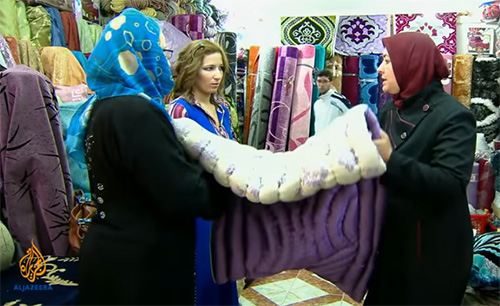
The bride pays particular attention to furnishing the bedroom. She has to strike the right balance between tradition and practicality. Also, they’re buying things to wear at the Turkish bath.
But the most time is spent choosing the bride's many outfits for the day itself. Mothers often make all the key decisions for their daughters.
“The bride meticulously prepares her trousseaux from the tiniest item to the biggest. There’s a popular saying in Algeria, ‘A one night wedding is a year’s preparation’. The bride attends to every detail of her outfits. She must appear in her most beautiful clothes on her wedding day. She parades before the guests like a queen, in her most attractive outfits”, says Hadjira Haichour, heritage researcher.
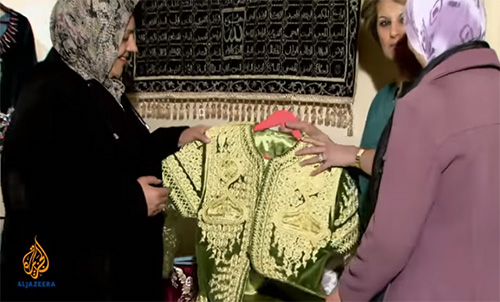
There's an amazing array and mix of styles, from the karakou from Algiers (a two-piece suit embroidered with gold and silver and worn with the traditional Arab trousers) to the gandoura from Constantine (a long velvet gown embroidered with gold thread) to costumes from other regions of Algeria.
All these embroidered dresses show the pride that Algerians take in their cultural identity and ancestral heritage.
“The bride’s dresses are very expensive. They’re embroidered with gold and silver thread and inlaid with gems and other accessories. The bride must be careful to choose colors representing happiness and optimism. She needs to look her absolute best, like a queen, on her wedding day”, adds Hadjira Haichour, heritage researcher.
“Weddings have always been costly for both bride and groom. The groom has to give a dowry to the bride. It can be a piece of gold jewelry, a set of 7 gold bracelets or the Meskiyaa or the Khamsa, a hand-shaped pendant which has symbolic meaning. It’s the hand of Prophet Mohammed’s daughter, to protect from the evil eye. The price of gold increases all the time today”, says Aya Nouria, heritage researcher.
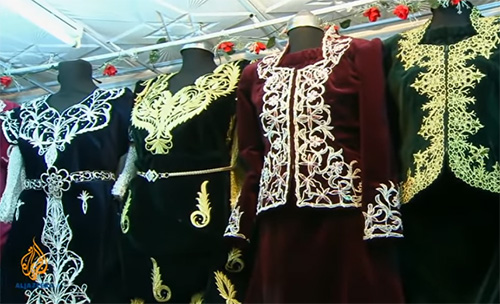
Jewelry is another key part of the bride's look. And Algerian gold jewelry is heavily influenced by Islamic and Andalusian designs. Like the armbands with different shapes inlaid with precious stones. Or the set of seven bracelets. The Meskiyaa necklace and, of course, earrings are all essential items.
Another traditional touch is a long necklace with the large oval pendant called “krafach boulahya”.
“Waiter, go around and serve everyone drinks, please. The lanterns and the candles light up the place and heighten our pleasure. As do the music and lovely melodies, too”, recites Samira Ben Ali, journalist.
Henna party
Bachelorette party
The next stage on the way to a wedding is the henna party. This is an all-women event at the bride’s house at sunset on the eve of the wedding day.
Mascara
The groom's female relatives arrive carrying a decorated handmade basket containing expensive gifts – outfits, perfumes, and jewelry. The contents are displayed before the guests, amid more whoops and popular wedding songs.
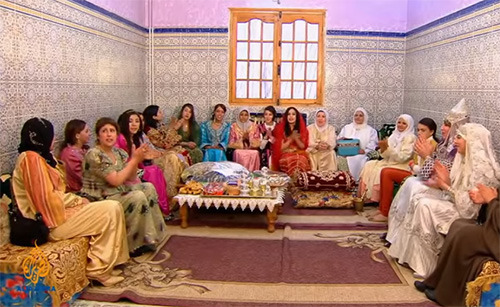
Henna is a symbol of joy and happiness and rosewater – a symbol of love and kindness. Mixed together, they double the bride's good luck.
In the heightened atmosphere, the bride’s mother-in-law puts the newly crushed henna mixture into the bride's palm, witnessed by the female guests. It has to be freshly crushed henna.
Then, the mother shows up the gold jewelry she's brought for her daughter-in-law as a token of generosity and respect. The more money gifted at a wedding, the prouder and happier both families will be. Generosity is an important feature of Algerian society. It matters, and a wedding is a full expression of this aspect of the people and their culture.
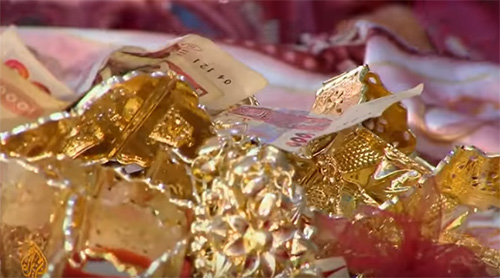
After the henna party… surprise, surprise! more food.
The bride’s family serves roast lamb with couscous and sauce.
The wedding's tomorrow, so no one's going hungry in Mascara.
Tlemcen
In more conservative Tlemcen, the bride’s henna party is also in full swing. The tradition here is for the mother-in-law to put a gold coin with henna in the bride's hand, covered with an embroidered white glove.
Then, she puts the Algerian traditional jewelry called “khit errouh” on the bride’s forehead. The name means “the thread of the soul” and this one’s studded with gold and precious stones.
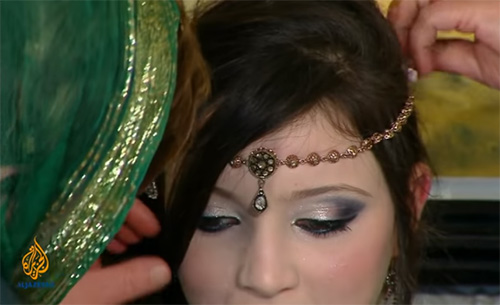
This is a more upmarket celebration and more restrained maybe. But the bride, her sister, and the rest of the girls are still up for a gentle rhythmical dance.
Bachelor party
On the same night, it's the grooms’ turn to have a bachelor party. His henna party is in his own home, with the older women in the family close by and the younger ones in the background.
The celebrations are based on Algerian tribal war dances.
The groom’s mother uses some of the henna remaining from the bride's henna party to put in her son's hand.
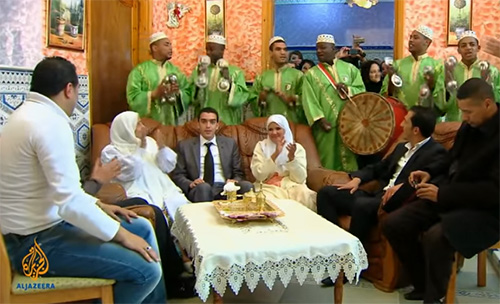
This couple’s wedding in Mascara is relatively modest, but there are a lot of guests. Which means they all have to be fed. Food is a really important part of the events and the hospitality. The groom's family hosts this meal during the wedding day – either at their home or at a hired venue.
While in the kitchen all kinds of exotic dishes are cooking, from local spicy meat and vegetable dishes to roasted meat and minced meatballs.
Dessert is sweet prune tagine with dried currants and roasted almonds.
Accepting an invitation to this meal is a way for friends and relatives to show their respect to the groom and his family.
“In the past, wedding celebrations might last a week. Today, they only last 24 hours because of cost”, narrates Hadjira Haichour, heritage researcher.
Public wedding celebration
Mascara
The next step for the happy couple is more of a public appearance than the kind of ceremony you'd see in other cultures and religions. It takes place at the bride's house and starts with the entrance of the bride and groom to the accompaniment of drums and music. Even at a relatively modest wedding celebration, the bride might wear as many as 7 or 8 different outfits.
To start with, the bride wears the traditional dress from the eastern city of Constantine the “gandoura fergani”, a long black velvet gown embroidered with gold thread.
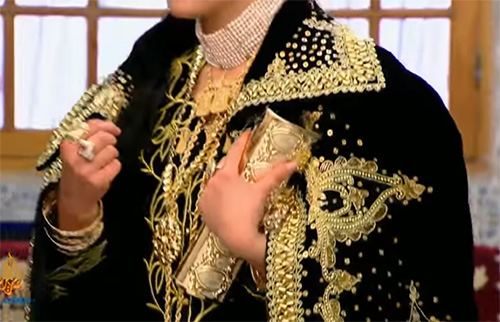
And later, they come back dressed in white symbolizing chastity and purity, the closest equivalent of a Christian or Western wedding dress.
This is a moment of true celebration. The bride and groom in wedding clothes, sitting together as a sign of their new union, with the female members of their families sharing their joy in dance.
Next, the moment the bride ceremonially leaves her parents’ house – a statement of the couple's new married status.
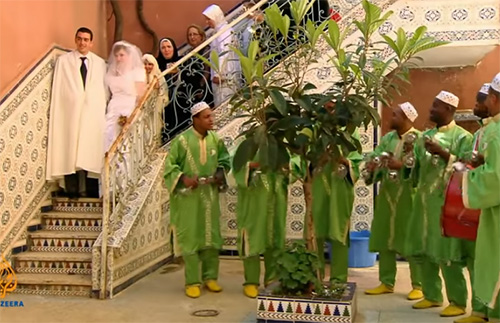
“It’s a regional tradition that when the bride leaves her parents’ house, she walks over an egg. It’s supposed to be a good omen for a bright future. There are other rituals, like the bride throwing sugar over the guests to sweeten her future life”, says Hadjira Haichour, heritage researcher.
For a family in Mascara, hosting a traditional wedding, observing tradition, is important and the traditional Fantasia performance on horseback is a part of that.
A group of armed horsemen in full battle dress charge information. Also called “the game of gunpowder”, it's based on the military traditions of the Berber and Arab desert horsemen.
“The Fantasia performance is very important. Horses are a sign of courage horsemanship. Gunpowder is a sign of manliness and virility”, comments Reda Ben Laldj, Fantasia horseman.
The couple are taken on a car parade through the streets and neighborhoods, stopping at specific locations for souvenir photos. To express their feelings toward their history and identity, the bride and groom make a stop at the Statue of El Amir Abdelkader, a symbol of Algerian resistance against colonialism and founder of the modern Algerian state.
They also stop for a photo opportunity under the dead Dardara tree, the place where the people of Mascara first swore allegiance to Emir Abdelkader in 1832.
At sunset, they arrive at the groom's house so that the bride can be welcomed by her mother-in-law with dates and milk. These traditions are deeply rooted in the Mascara region. The white of the milk and the sweet taste of dates are considered a good omen for the couple and a sign of affection and welcome for the bride.
The bride soaks up the atmosphere of the warmth at the moment, surrounded by members of her new family.
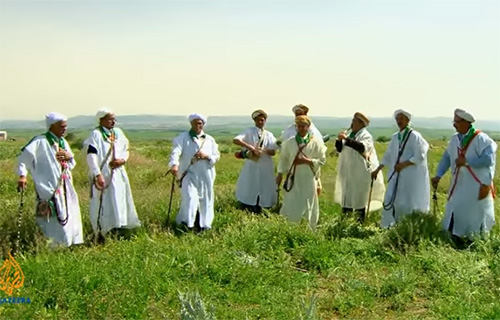
“In Algeria, especially in the west, both men and women dance. We say, ‘Women dance but men play’ because the male dance is a ritual training for battle. It’s inspired by war games dating back to Algerian resistance against invaders. Dancers wear loose trousers and a white gandoura linen robe. They’re knights rather than dancers”, says Assia Mehdeb, folklore researcher.
Tlemcen
In Tlemcen, the bride’s ceremonial exit from her parents’ house is altogether more extravagant.
“The chedda is the outfit that appears the most in Tlemcen wedding ceremonies. The bride wears the kaftan and the chedda. She leaves her parents’ house covered by a Hayek, a long silk garment. The real ceremony starts here and music is always played. Everybody waits for the bride to come out of her parents’ house. The bride is then taken on a car parade through the city”, narrates Aya Nouria, heritage researcher.
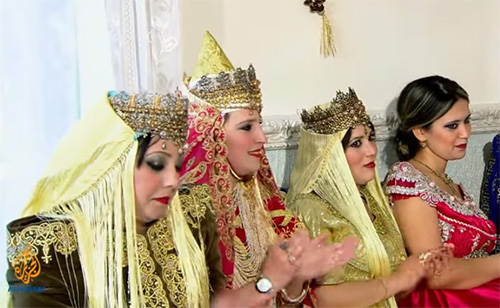
The wedding in Tlemcen is slightly more upmarket. The bride leaves wearing the local beautiful bridal costume and enveloped in a white silk haik.
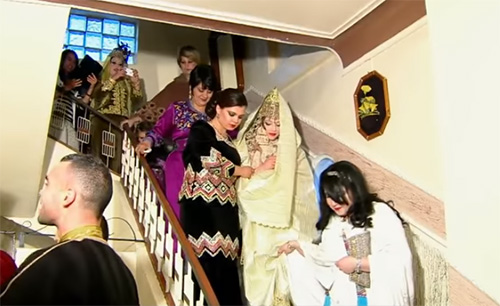
The wedding procession moves off towards the family home of her new husband. And the Fantasia horsemen go with them.
The groom’s sisters and his recently married relatives welcome the bride, dancing to the traditional music, all wearing the chedda.
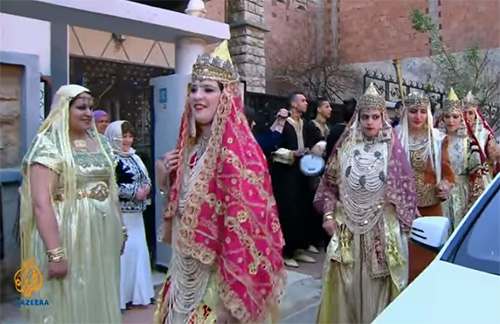
The Fantasia starts the public celebrations. The horsemen attract crowds – what better way of announcing your marriage to the world.
Similar to the bride in Mascara, this bride in Tlemcen is also welcomed with milk and dates, a way to wish her a white and bright future with her new family.
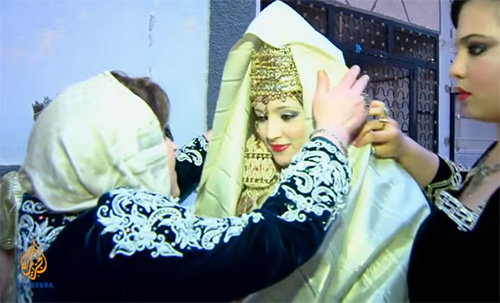
In another ritual, the bride’s mother-in-law offers her a key so that Allah may open every door for her.
“Once inside, the bride sits and remains covered by the long hayek. The most recently-married female guests dance around her and sing traditional songs. Then, her mother-in-law draws a red spot with white pin points on her cheeks. The red spot symbolizes shyness and the white points mean she’ll blossom like a flower”, tells us Djamila Mahtari, heritage researcher.
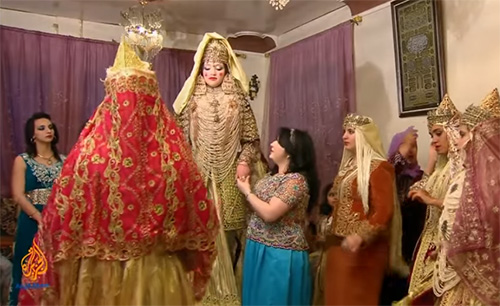
The couple’s wedding celebration continues into the night. Don't forget, he has yet to meet his bride on his wedding day. But that's about to change.
Dressed in a white silk burnous, the groom mounts a horse and sets off to meet his new wife, accompanied by Fantasia horseman.
And another ritual handed down over the generations – the groom gets ready to throw his burnous to his friends amid the gunfire. And more whoops.
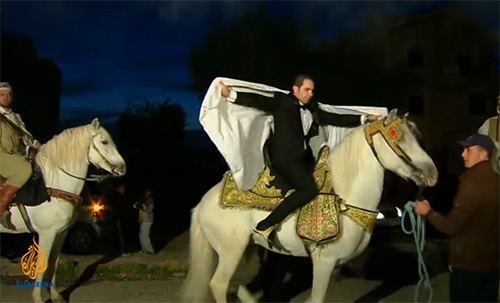
His mother sends him off with the Hand of Fatima necklace to protect him from the evil eye. Dressed in a beautiful chedda, his sister wipes the sweat from his brow.
Then, he makes the trip on horseback to his home to meet his bride and uncovers her face in the presence of guests and family.
And it's photo time for the family album.
The chedda that the bride is wearing, the Tlemcen bridal costume, is so highly prized that UNESCO has put it on its List of Intangible Cultural Heritage. It used to be worn by princesses and notables of the Zayyanid Kingdom. It is made of several layers of silk and accessories, of velvet caftan embroidered with gold thread, plus the pointed cap and long earrings.
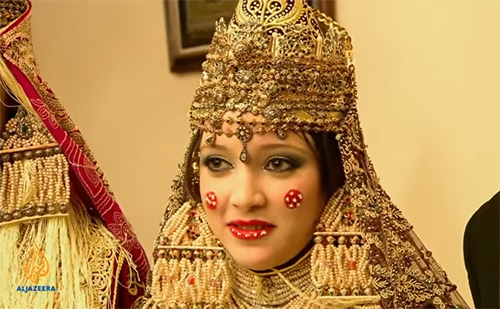
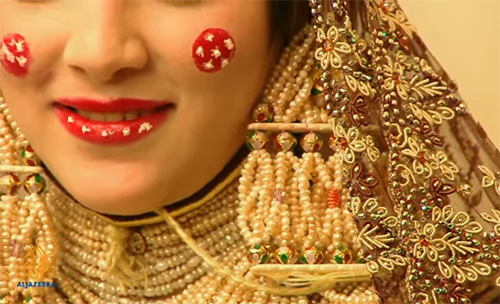
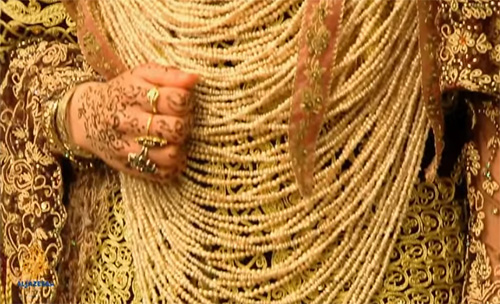
“The Tessdira is a kind of fashion parade. Each half an hour, the bride appears with a new costume. Friends and relatives take pictures with her. They dance and sing with her to express their joy and happiness”, says Hadjira Haichour, heritage researcher.
Earlier in the day, the bride did her Tessdira, a kind of bridal fashion show.
One of her costumes is a karakou, the wedding outfit of Algiers. Although many of the rituals and costumes are common to all traditional marriages, there are variations depending on wealth, region, and social status.
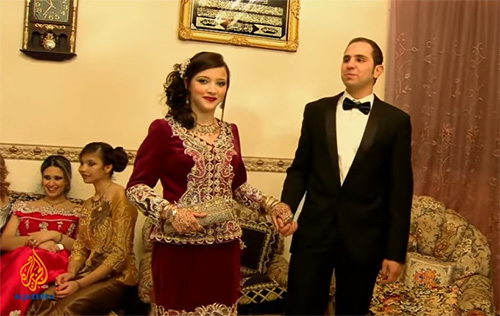
Algeria is a modern country, but ritual runs deep in wedding celebrations here. And the wedding itself is one of the most colorful, cheerful, bright, and bejeweled in the whole world. There are few countries where you can see as many bridal jewelry, spectacular activities, and different décor embellishments as in Algeria.
(c)
